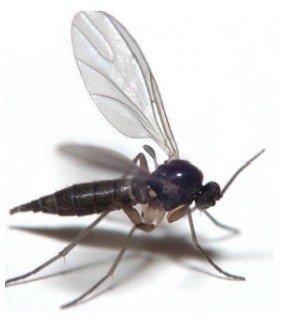I have been having a problem with fungus gnats in and around my potted plants. I was told that if I diluted regular Listerine, 1 to 1 with water and spayed the organic soil mixture, the solution, would kill fungus gnats and their eggs that live in the manure.
Hardiness Zone: 6a
By Lady Belle 13 from Philadelphia, PA
Add your voice! Click below to answer. ThriftyFun is powered by your wisdom!
To break the cycle of the fungus gnat you need to get rid of the larvae. It's very simple and easy. A slice of potato is all you need. Simply lay the slice on the soil of infested plants and the little maggots can't resist it. They begin feeding in the slice and now you have them where you want them. Throw the slice away after about 3 or 4 days and replace as needed. Of course there are other ways and this article may help. But making sure it's fungus gnats is key here because this trick won't work on other types. Hope this helps.

These things suck - become an unfortunate 'field of study' for me, haven't found one particular thing that works perfectly for me - but I thought I'd pass on a few things to consider, just in case anyone else missed them!
1. They seem especially drawn to two things first plants in pots that are too big for them (thus they are surrounded by damp soil that the root system isn't using). And fertilizer.
To remedy these things:
1. Stay away from miracle-gro potting soil (the cheaper potting mix seems to have a lot less problems.
2. Bake all potting soil - new or used - for an hour on 250-300 degrees F before using it. also when transplanting rinse the roots outside well and either dispose of the old soil or bake it.
3. Skip gravel/rocks in the bottom of the pot, and only water from the bottom using a saucer, after a few minutes toss any water left that the plant hasn't absorbed. Sometimes it takes a few waterings for the root system to figure out where the water is coming from but they will adjust, and skipping the gravel in the bottom of a pot speeds this up.
Note - Certain plants like philodendrons get them repeatedly, and I have had better luck putting them in a tall narrow vase of water instead permanently. Sometimes I just move outside.
4. Very important (as I too have a 'Charlie Brown Christmas tree' sort of tendency to feel sorry for sickly plants and try to nurse them back to health)
If you discover a plant that has these gross gnats (usu. in a bath or bedroom that you don't pay much attention to - you will recognize them by the fact that they 'run around' the edges of the pot more so than they "fly" and on the surface around it) bag the whole thing and throw it away, or like I do - toss it off of the balcony onto the lawn then later go with a garbage bag, wrap it up and throw it away! You will save yourself many headaches.
Then go around and check all of the plants inside and out, and even if you don't immediately notice any gnats, take the first couple of inches of soil off of the top of all of them and throw it away! : ) Replace it with new baked soil. Don't fertilize so often, and let the plants dry out between watering.
P.S. to the person who wrote about the 'decline' of plants after; this seems to be a direct result of these gnats. Either that the gnat larvae eating the roots of the plants, or because as a result of the infestation, predator nematodes (which feed on the larvae) themselves become a parasite to the plant. In my experience the plants almost never recover after this, even after changing the soil etc. Save the grief and toss the plant in the first place. They're not that expensive, and you probably have too many anyway.
Oh also - open up your windows more often more sunlight and fresh air is their enemy and you'll feel better (and your house will be a healthier environment). Do it now! Good luck!
Add your voice! Click below to answer. ThriftyFun is powered by your wisdom!